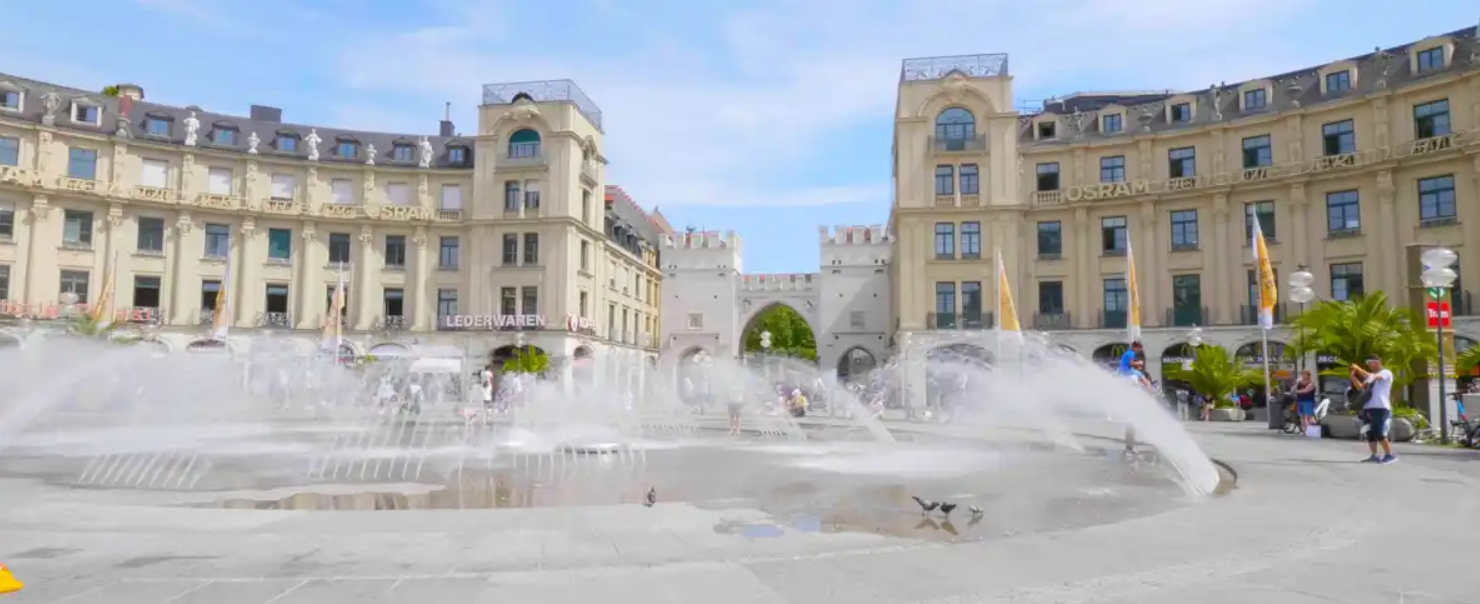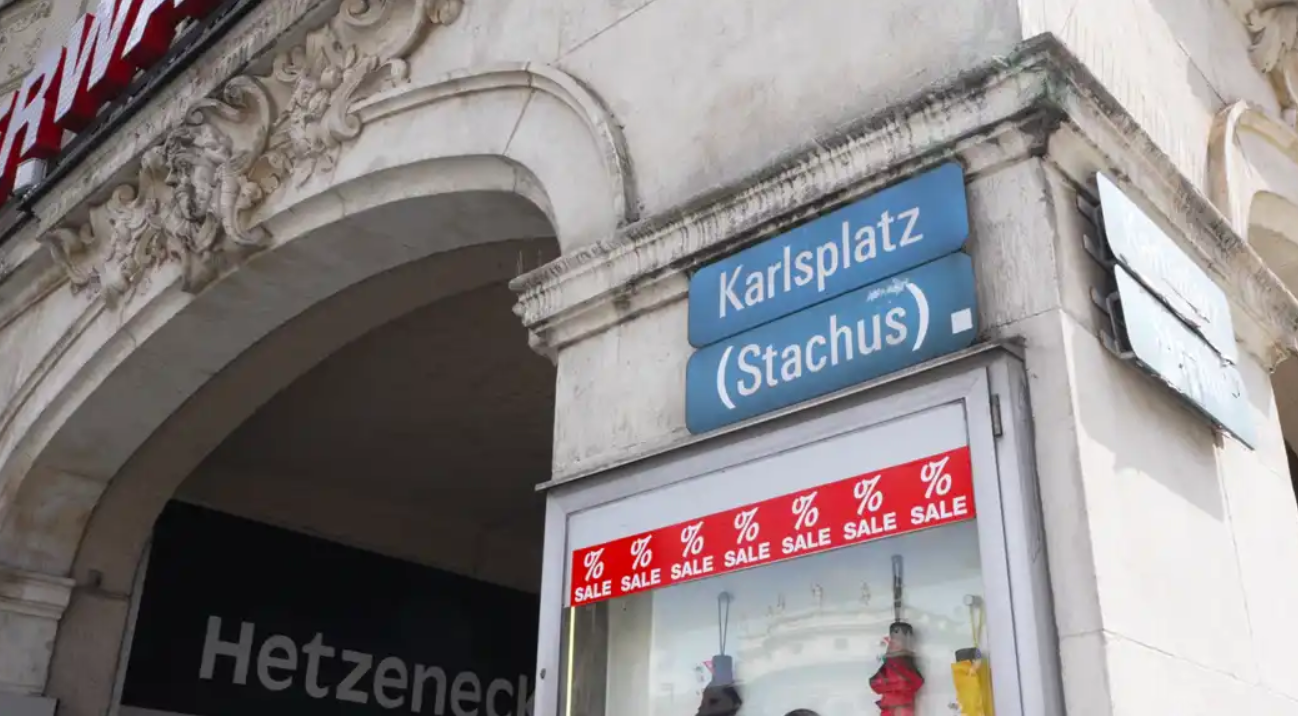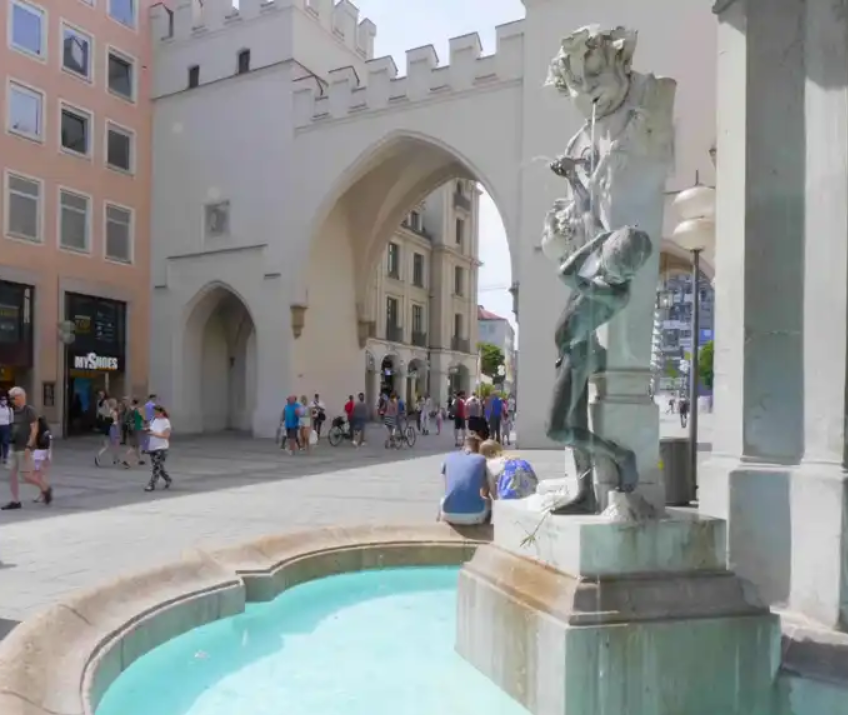Munich’s lively meeting place between history and modernity
Address: Karlsplatz 1, 80335 Munich | Built: 1791/92 (as Neuhauser-Tor-Platz)
One of the most famous squares in Munich is Karlsplatz, named after Elector Karl Theodor. However, this square has also been called “Stachus” by locals for centuries. The name comes from an inn that used to be located on Karlsplatz and was run by Eustachius Föderl. Both then and now, Karlsplatz is one of the liveliest and busiest squares in all of Europe. Almost every means of public transport in Munich goes to Stachus, and from there, almost all destinations in the Bavarian capital that are within the city limits can be reached. Karlsplatz is framed by magnificent buildings and features an impressive fountain. The Stachus fountain is a meeting place for anyone seeking a refreshing dip in the summer. In winter, you can enjoy the wonderful atmosphere at Karlsplatz during the Munich Ice Magic.
Directions and Location of the Munich Landmark
Centrally located in Munich’s city center is Karlsplatz, unofficially known as Stachus. As an important transportation hub, numerous sights and attractions in the Bavarian capital can be reached from there. It is also one of the city’s most famous squares.
Stachus is located west of Marienplatz. From here, the pedestrian zone leads visitors directly into Munich’s city center. Karlsplatz is lined with historic buildings and numerous shops. The dominant feature of Stachus is the neo-Gothic city gate, which marks the western end of Kaufingerstraße. This is one of Munich’s main shopping streets and leads directly to Marienplatz.
Also not far from Karlsplatz are the Catholic Church of St. Michael, the Old Botanical Garden, Lenbachplatz, and other interesting sights and attractions.
Opening Hours and Tours
As Karlsplatz in Munich is a public square, Stachus can be visited at any time of day or night, year-round. A charming atmosphere is created in the evening hours when lanterns illuminate the square and its impressive fountain, and spotlights bathe the Karlstor Gate and surrounding buildings in soft light.

Entrance Fees for Karlsplatz (Stachus)
There are no entrance fees for visiting Karlsplatz (Stachus).
Guided Tours of Stachus
Tours focusing exclusively on Karlsplatz (Stachus) are not offered.
FAQ – Frequently Asked Questions about Karlsplatz
Why is Karlsplatz also called Stachus?
Back then, where the Kaufhof department store stands today, there was an inn called Stachus, run by a certain Eustachius Föderl. Merchants, traders, travelers, and locals met there, which meant there was always something going on in the inn. Even today, the Bavarian saying “Da geht es zu wie am Stachus” (It’s like being at Stachus) is still used, meaning “bustling activity.”
In which district of Munich is Karlsplatz “Stachus” located?
Stachus is located in the 3rd district, which stretches from Odeonsplatz to Karlsplatz and directly borders the Old Town. To the east, the English Garden forms the boundary of the 3rd district.
What special features can be discovered at Karlsplatz “Stachus”?
A notable building at Stachus is the Karlstor (Karl’s Gate). This historic building is a former city gate of Munich and forms the gateway to Kaufingerstraße, one of the main shopping streets in the Bavarian capital. Other attractions include the Karlsbrunnen (Charles Fountain) with its water fountains and the Stachus Passagen (Stachus Passages). This underground shopping center with numerous shops opened in November 1970.
Which historic buildings are located at Karlsplatz?
An imposing, historic building at Karlsplatz, between Elisenstraße and Prielmayerstraße, is the Palace of Justice in the neo-Baroque style. The building, with its enormous dome, dominates the cityscape at Stachus. This building houses the Bavarian Ministry of Justice.
Which city gate is located at Karlsplatz, “Stachus”?
The city gate located at Stachus is the Karlstor. It was built in 1300 and was called the Neuhauser Tor until 1791. The Karlstor was formerly the western city gate and served as the entrance to Munich’s historic old town.
What makes the fountain at Karlsplatz so special?
The fountain at Stachus, called the Karlsbrunnen, has 199 jets that create water jets and refract sunlight in a special way. It’s considered a symbol of joie de vivre in Munich. There’s nothing more beautiful than sitting at the Karlsbrunnen on a hot summer day and enjoying the view.
Karlsplatz (Stachus) – Special Features and Interesting Facts
After the Second World War, Karlsplatz was dominated by street traffic and public transport. It only became quieter in 1972, when a pedestrian zone was created behind the Karlstor. This was prompted by the 20th Summer Olympic Games. By banishing street traffic, Kaufingerstraße and Neuhauser Straße all the way to Marienplatz became the largest shopping street in the Bavarian capital.
A spacious transport center was built beneath Stachus for public transport. Various subway, S-Bahn, and tram lines serve Stachus, making the underground station a major hub. There is also a shopping center underground, the Stachus Passagen.
Stachus also has a lot to offer from an architectural perspective. It features an expressive combination of historic buildings and modern elements. The old Karlstor blends harmoniously with the modern buildings, hotels, and shops surrounding Stachus. The result is a unique blend of modernity and tradition.
In addition to the Karlstor, Karlsplatz in Munich is surrounded by other landmarks and important buildings. One imposing building is the Palace of Justice. This dates back to the 19th century and was built in the Neo-Baroque style. Another building, also built in the Neo-Baroque style, is the new courthouse. This is located opposite the Palace of Justice.
Another special feature of Karlsplatz is the large fountain located in the center of Stachus. While the fountain is a popular meeting place for extensive shopping trips in the summer, this area transforms into a remarkable ice rink in the winter.

Historical Facts and History of Munich’s Karlsplatz
Karlsplatz, also known as Stachus, is one of the most famous squares in the Bavarian capital. The story of how the square got its name “Stachus” still brings a smile to people’s faces today.
After the Wittelsbach line threatened to die out in 1777, Elector Palatine Karl Theodor took over the government of Bavaria. He was not particularly popular, as his political ambitions did not match the people’s expectations. The new ruler wanted to exchange all of Bavaria for estates and possessions in Austria.
The locals’ displeasure grew even greater when he simply renamed various places after himself. This is how Karlsplatz and the Karlstor gate also got their names. The people didn’t like this at all. They promptly named the square after the Stachus inn, which Eustachius Förderl ran on the square. To this day, true Munich residents don’t use the name Karlsplatz, but simply Stachus. The addition of “Stachus” is also a must in announcements on subways and trams.
The area was once an open square located in front of the old city walls. During the 18th and 19th centuries, Stachus, with its city gate, became an important transportation hub. The Karlstor is one of the three city gates dating back to the time of the city fortifications and is still preserved.
Due to the city’s expansion in the 19th century, Stachus was further expanded. Representative buildings were built in the surrounding area. The original design was changed several times in the 20th century. Especially after the end of World War II, parts of the surrounding buildings were rebuilt.
The construction of the underground transportation center beneath Stachus was a significant moment in the square’s history. By connecting the S-Bahn and U-Bahn, Karlsplatz became a major transportation hub in Munich. Today, the remarkable combination of historical architecture and modernity creates a very special flair.

Brunnenbuberl am Karlstor München
Sights and attractions in the immediate vicinity of Karlsplatz
In the immediate vicinity of Stachus are numerous attractions and sights that are sometimes not immediately noticeable and rather inconspicuous. However, if you walk across Karlsplatz and through the pedestrian zone with your eyes open, you will find true gems that will make your heart race.
If you walk through the Karlstor, you can discover many special features in the archway. The corners are decorated with heads, the so-called Kragenköpfe (collar heads). It depicts the coachman Krenkl, a true legend. He coined the saying “Wer ko, der ko” (If you can’t, you can’t). You can also recognize the Finessensepperl (Finessensepperl), the last court jester, and Baron Sulzback. They all look down on passersby.
Near Stachus, on Neuhauser Straße, is the Bürgersaalkirche (Church of the Citizens), which at first glance is not immediately noticeable. The building, rather plain on the outside, only reveals its true beauty on the inside. The church’s interior is decorated with opulent ceiling and wall paintings and offers other impressive features.
The Palace of Justice, with its large domed roof, is not only an impressive building with imposing architecture. Since the Hotel Königshof was demolished, the building has once again been revealed in its full grandeur from the Stachus square. In the Palace of Justice, history comes alive and can be experienced firsthand.
At the beginning of the pedestrian zone, directly behind the Karlstor, there is a magical fountain. The Brunnenbuberl (literally “fountain boy”), also known as the Gastein Fountain, depicts a satyr and a boy being drenched in water by the faun. The fountain was created by the sculptor Mathias Gastein. The fountain is particularly impressive in winter. Since the water is not turned off, magical ice cascades are created, adorning the Brunnenbuberl (literally “fountain boy”).
Another impressive building is St. Michael’s Church on Neuhauser Straße. This Roman Catholic church is the first church in Germany to be built in the Renaissance style. The exterior façade is adorned with 15 statues depicting the former rulers of Bavaria. The tomb of King Ludwig II and Elector Maximilian I is located there. Also striking inside the church are the vaults, arches in the side aisles, and the choir arch, all reminiscent of triumphal arches.
Cafés and Restaurants Near Karlsplatz in Munich
While strolling through the Stachus square and the nearby pedestrian zone, numerous cafés and restaurants invite you to linger and enjoy. The offerings range from regional delicacies to national and international cuisine, as well as coffee and cake specialties. The restaurants and cafés exude rustic coziness or offer modern interiors, creating a feel-good atmosphere. There’s something for everyone.
Kubaschewski Bar
Located directly on Karlsplatz is the Kubaschweski Bar. It’s the perfect place to unwind after a long stroll and shopping experience. Guests are treated to original and unusual drinks in a sophisticated ambiance. When the weather’s nice, the outdoor area invites you to linger and enjoy a unique view of the vibrant hustle and bustle of Stachus.
Address: Kubaschewski Bar, Karlsplatz 5, 80335 Munich
Greta Oto Munich on Karlsplatz offers its guests Spanish and Latin American cuisine in a stylish setting. The diverse dishes are prepared fresh and with great passion. In addition to numerous dishes, the menu also includes delicious cocktails and long drinks. In good weather, you can enjoy a fantastic view of the city from the rooftop terrace.
Address: Greta Oto Munich, Karlsplatz 25, 80335 Munich
The Café im Hugendubel exudes a charm all its own. Surrounded by books, delicious coffee specialties are served. These are prepared not only in the traditional way, but also with vegan milk alternatives. The menu includes small dishes such as salad creations or Kaiserschmarrn (sweet pancakes) to satisfy a small appetite. The friendly and attentive staff perfectly rounds off a visit to the Café im Hugendubel.
Address: Café im Hugendubel, Karlsplatz 11, 80335 Munich
LEGER am Dom is located on Kaufinger Straße. Guests can sit outside in nice weather and watch the hustle and bustle of the shopping district. The menu features European and international cuisine. Those who are out early can also enjoy a delicious breakfast at LEGER. The delicacies that emerge from the kitchen are true culinary delights, prepared with finesse.
Address: LEGER am Dom, Kaufingerstraße 24, 80331 Munich
Jacob am Lenbachplatz offers its guests delicacies from Israeli, French, and Mediterranean cuisine. In a tasteful ambiance, it’s easy to forget the stresses of everyday life. The dishes are freshly prepared. Even special requests are promptly fulfilled by the friendly, attentive staff. The restaurant is the ideal place to enjoy a delicious meal and end the evening in style.
Address: Jacob, Lenbachplatz 2a, 80333 Munich
Schnitzelwirt
In a rather rustic setting, the Schnitzelwirt serves unique schnitzel creations and dishes from German, European, and Central European cuisine. Those looking for a quick and uncomplicated meal will find a comfortable spot for lunch and dinner. Large and tasty portions are served, so no one leaves the restaurant hungry. A wide selection of drinks completes the restaurant experience.
Address: Schnitzelwirt, Neuhauser Straße 39, 80331 Munich